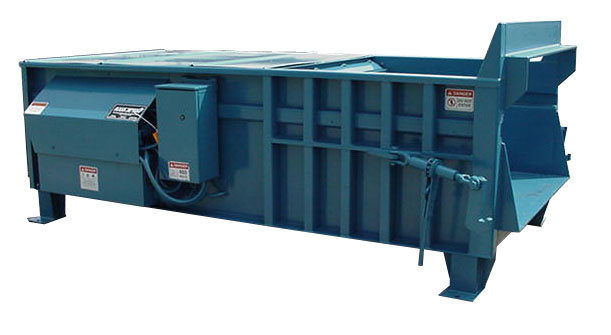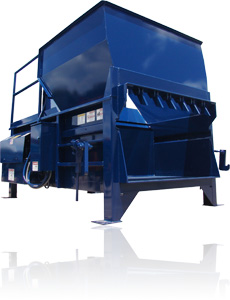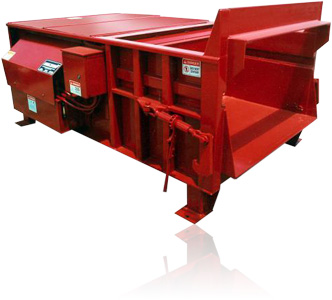Why Commercial garbage compaction equipment is preferred by many businesses
Understanding the Various Uses of Waste Devices in the Recycling Industry
The reusing industry relies heavily on specialized waste devices to maximize processing and recovery. Each tool, from shredders to balers, offers a distinctive function that improves overall efficiency. Understanding these duties is vital for enhancing sustainability initiatives. Commercial garbage compaction equipment. As technology breakthroughs, new developments arise, assuring to transform standard methods. This advancement elevates important questions concerning the future of waste management and its impact on environmental preservation. What adjustments lie in advance for this important industry?
The Duty of Shredders in Material Processing
Shredders play a critical duty in the reusing market by effectively processing various sorts of waste products. These machines are created to decrease big items, such as plastics, metals, and organic waste, into smaller, manageable pieces. This size decrease is vital for succeeding recycling processes, as it permits much easier handling and sorting. Along with assisting in recycling, shredders boost safety by lessening the danger of injury related to managing large waste things.
Furthermore, shredders add to ecological sustainability by ensuring that products are refined in such a way that optimizes resource recovery. They can handle a diverse series of products, making them versatile tools in waste administration centers. The effective operation of shredders not only streamlines the recycling procedure yet additionally enhances the general performance of waste diversion initiatives, advertising a circular economic climate. Their significance in product processing can not be overstated, as they work as a foundational step in the direction of sustainable waste administration methods.

Exactly How Balers Enhance Efficiency in Waste Management
Balers significantly boost effectiveness in waste management by condensing different products right into bales, which simplifies storage and transportation. By pressing recyclables such as cardboard, plastics, and metals, balers considerably minimize the quantity of waste. This compression not just maximizes room in reusing centers yet additionally decreases the variety of trips called for to move products, resulting in reduced fuel costs and decreased ecological effect.
Additionally, balers add to enhanced safety in waste monitoring operations. Compact bundles are much easier to stack and take care of, minimizing the danger of accidents connected with loose materials. The uniform size of bundles enables for more efficient filling and unloading processes, streamlining operations within reusing facilities. In addition, balers can improve the overall high quality of recyclables, as appropriately compacted products are less most likely to be contaminated. On the whole, balers play a crucial role in maximizing waste monitoring methods, advertising sustainability in the recycling market.
Conveyor Equipments: Enhancing the Recycling Refine
Incorporating innovative equipment like balers substantially boosts waste management operations, yet the efficiency of the recycling process is even more enhanced via the usage of conveyor systems. These systems play an important role in the seamless transport of materials within recycling facilities. By promoting the movement of various waste kinds, conveyor systems lessen manual handling and decrease the danger of contamination throughout the reusing process.
In addition, conveyor systems can be tailored to fit the distinct formats and operational requirements of reusing facilities. Their capability to click this link operate continuously permits a steady circulation of materials, enhancing efficiency and making sure that processing and sorting devices gets a consistent supply.
Furnished with features like flexible rates and automated controls, conveyor systems can optimize the circulation of products, considerably improving general effectiveness (Commercial garbage compaction equipment). Subsequently, these systems are important in modern recycling operations, adding and simplifying processes to reliable waste management
Sorting Equipments: The Secret to Material Healing
Sorting devices are essential components in the reusing sector, considerably boosting the effectiveness of product healing. These makers play a crucial duty in the splitting up of numerous recyclable products, permitting a streamlined process that takes full advantage of resource removal. By making use of innovative innovations, such as optical sensors and air classifiers, arranging makers can determine and classify materials based on their composition, weight, and dimension. This capacity ensures that steels, plastics, and paper products are successfully isolated, minimizing contamination and enhancing the high quality of recycled result.
The operation of arranging makers considerably decreases the dependence on manual work, which can be both lengthy Learn More and susceptible to mistakes - Commercial garbage compaction equipment. Additionally, the automation offered by these machines increases the total recycling process, causing greater throughput and enhanced operational performance. As a result, arranging makers are crucial in accomplishing sustainable waste administration objectives, enabling the reusing industry to efficiently recover beneficial materials while minimizing garbage dump dependency

Advancements in Waste Devices for a Lasting Future
Current innovations in waste tools are driving the recycling industry toward an extra sustainable future. Innovations such as automated arranging systems, which use man-made intelligence and artificial intelligence, improve performance by accurately recognizing and dividing recyclables. This results in higher recovery rates and decreased contamination. Additionally, advancements in compacting modern technology permit much more reliable transportation of materials, minimizing carbon impacts throughout transit.
Improvements in shredding devices enhance the processing of intricate products, allowing the recycling of products that were as soon as regarded non-recyclable. The assimilation of renewable power sources, like solar energy, in waste processing facilities additionally adds to sustainability goals. Furthermore, advancements in waste-to-energy modern technologies and naturally degradable products are reshaping the landscape of waste administration. Collectively, these improvements represent a transformative shift within the reusing sector, promoting not just environmental defense however likewise financial viability for future generations.
Regularly Asked Questions
What Kinds Of Materials Can Waste Devices Handle?
The sorts of products waste equipment can take care of consist of plastics, steels, paper, glass, and natural waste. Each tools kind is made for certain products, enhancing performance and effectiveness in sorting and refining various waste streams.
Exactly How Frequently Should Waste Equipment Be Maintained?

Exist Safety Problems With Utilizing Waste Tools?
Security issues with using waste devices consist of prospective injuries from mechanical breakdowns, exposure to harmful materials, and poor training. Correct upkeep, normal assessments, and employee education and learning are necessary to reduce these dangers properly in any kind of setup.
What Is the Average Lifespan of Recycling Devices?
The average lifespan of reusing tools usually ranges from 10 to twenty years, depending upon variables such as usage strength, upkeep methods, and technological improvements, which can substantially influence longevity and performance over time.
Exactly How Is Waste Equipment Powered in Recycling Facilities?
Waste tools in recycling facilities is generally powered by electrical energy, though some devices may utilize different power sources like natural gas or diesel. This power allows effective handling and improvement of products for recycling purposes.
Shredders play a vital duty in the recycling sector by efficiently refining numerous kinds of waste materials. They can manage a diverse range of materials, making them functional devices in waste administration centers. Balers greatly improve efficiency in waste monitoring by condensing various materials right into bales, which simplifies storage space and transportation. The kinds of products waste devices can manage include plastics, metals, paper, glass, and organic waste. Security problems with making use of waste devices include potential injuries from mechanical breakdowns, exposure to harmful materials, and inadequate training.